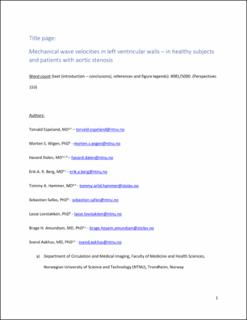| dc.contributor.author | Espeland, Torvald | |
| dc.contributor.author | Wigen, Morten Smedsrud | |
| dc.contributor.author | Dalen, Håvard | |
| dc.contributor.author | Berg, Erik Andreas Rye | |
| dc.contributor.author | Hammer, Tommy Arild | |
| dc.contributor.author | Salles, Sebastien Andre Roger | |
| dc.contributor.author | Løvstakken, Lasse | |
| dc.contributor.author | Amundsen, Brage H. | |
| dc.contributor.author | Aakhus, Svend | |
| dc.date.accessioned | 2023-10-19T07:52:09Z | |
| dc.date.available | 2023-10-19T07:52:09Z | |
| dc.date.created | 2023-10-18T10:05:39Z | |
| dc.date.issued | 2023 | |
| dc.identifier.issn | 1936-878X | |
| dc.identifier.uri | https://hdl.handle.net/11250/3097451 | |
| dc.description.abstract | Background
Mechanical wave velocity (MWV) measurement is a promising method for evaluating myocardial stiffness, because these velocities are higher in patients with myocardial disease.
Objectives
Using high frame rate echocardiography and a novel method for detection of myocardial mechanical waves, this study aimed to estimate the MWVs for different left ventricular walls and events in healthy subjects and patients with aortic stenosis (AS). Feasibility and reproducibility were evaluated.
Methods
This study included 63 healthy subjects and 13 patients with severe AS. All participants underwent echocardiographic examination including 2-dimensional high frame rate recordings using a clinical scanner. Cardiac magnetic resonance was performed in 42 subjects. The authors estimated the MWVs at atrial kick and aortic valve closure in different left ventricular walls using the clutter filter wave imaging method.
Results
Mechanical wave imaging in healthy subjects demonstrated the highest feasibility for the atrial kick wave reaching >93% for all 4 examined left ventricular walls. The MWVs were higher for the inferolateral and anterolateral walls (2.2 and 2.6 m/sec) compared with inferoseptal and anteroseptal walls (1.3 and 1.6 m/sec) (P < 0.05) among healthy subjects. The septal MWVs at aortic valve closure were significantly higher for patients with severe AS than for healthy subjects.
Conclusions
MWV estimation during atrial kick is feasible and demonstrates higher velocities in the lateral walls, compared with septal walls. The authors propose indicators for quality assessment of the mechanical wave slope as an aid for achieving consistent measurements. The discrimination between healthy subjects and patients with AS was best for the aortic valve closure mechanical waves. (Ultrasonic Markers for Myocardial Fibrosis and Prognosis in Aortic Stenosis; NCT03422770
) | en_US |
| dc.language.iso | eng | en_US |
| dc.publisher | Elsevier | en_US |
| dc.rights | Navngivelse 4.0 Internasjonal | * |
| dc.rights.uri | http://creativecommons.org/licenses/by/4.0/deed.no | * |
| dc.title | Mechanical wave velocities in left ventricular walls – in healthy subjects and patients with aortic stenosis | en_US |
| dc.title.alternative | Mechanical wave velocities in left ventricular walls – in healthy subjects and patients with aortic stenosis | en_US |
| dc.type | Peer reviewed | en_US |
| dc.type | Journal article | en_US |
| dc.description.version | acceptedVersion | en_US |
| dc.rights.holder | © 2023 Elsevier | en_US |
| dc.source.journal | JACC Cardiovascular Imaging | en_US |
| dc.identifier.doi | 10.1016/j.jcmg.2023.07.009 | |
| dc.identifier.cristin | 2185805 | |
| cristin.ispublished | true | |
| cristin.fulltext | postprint | |
| cristin.qualitycode | 2 | |

